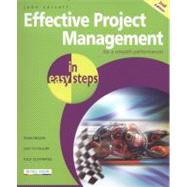
Note: Supplemental materials are not guaranteed with Rental or Used book purchases.
Purchase Benefits
| The Basics | p. 7 |
| Introduction | p. 8 |
| What is a Project? | p. 9 |
| Project Management | p. 10 |
| Managing a Project | p. 12 |
| 4 Steps to Success | p. 14 |
| Responsibility & Authority | p. 15 |
| Good Project Managers | p. 16 |
| Project Management Style | p. 18 |
| Summary | p. 20 |
| Getting Started | p. 21 |
| Starting a Project | p. 22 |
| Assembling the Team | p. 24 |
| The Project Organization | p. 26 |
| Why Projects Go Wrong | p. 28 |
| Getting it Right | p. 30 |
| Terms of Reference | p. 32 |
| Creating the Terms of Reference | p. 34 |
| Project Planning | p. 36 |
| Summary | p. 38 |
| The Business Case | p. 39 |
| Feasibility | p. 40 |
| The Business Case | p. 42 |
| Example Business Case | p. 43 |
| Developing the Costs | p. 44 |
| Investment Appraisal | p. 46 |
| Cash Flow Model | p. 48 |
| Reviewing the Business Case | p. 50 |
| Summary | p. 52 |
| Planning | p. 53 |
| Objectives | p. 54 |
| Constraints | p. 56 |
| Starting the Plan | p. 58 |
| Structuring the Plan | p. 60 |
| Work Breakdown Structure | p. 62 |
| Estimating | p. 64 |
| Task Size | p. 66 |
| Summary | p. 68 |
| Scheduling | p. 69 |
| Work Effort & Duration | p. 70 |
| Contingency | p. 72 |
| Applying Contingency | p. 74 |
| Scheduling | p. 76 |
| Project Schedule | p. 78 |
| Gantt Charts | p. 80 |
| Scheduling Tools | p. 82 |
| Critical Path | p. 84 |
| Developing the Schedule | p. 85 |
| Agile Projects | p. 86 |
| Summary | p. 88 |
| Risk Management | p. 89 |
| Types of Risk | p. 90 |
| Managing Risk | p. 92 |
| Risk Identification | p. 94 |
| Risk Estimation | p. 96 |
| Risk Evolution | p. 98 |
| Countermeasures | p. 100 |
| Risk Log | p. 102 |
| Risk Management | p. 104 |
| Summary | p. 106 |
| Organizing | p. 107 |
| Getting Organized | p. 108 |
| Resources | p. 110 |
| The Stage Plan | p. 112 |
| Organizing Activities | p. 114 |
| Activity Schedules | p. 116 |
| Software Development | p. 118 |
| Documentation | p. 119 |
| Summary | p. 120 |
| Leading | p. 121 |
| Stakeholders | p. 122 |
| The Change Process | p. 124 |
| Teamwork | p. 126 |
| Team Building | p. 128 |
| End Users | p. 130 |
| The Leadership Role | p. 132 |
| Effective Communications | p. 134 |
| Communications Plan | p. 136 |
| Difficult People | p. 138 |
| Summary | p. 140 |
| Control | p. 141 |
| Keeping Control | p. 142 |
| Project Meetings | p. 144 |
| Measuring Progress | p. 146 |
| Project Reports | p. 148 |
| Change Control | p. 150 |
| Dealing with Change | p. 152 |
| Stage Boundaries | p. 154 |
| Summary | p. 156 |
| Project Stages | p. 157 |
| Project Life Cycle | p. 158 |
| Project Road Map | p. 159 |
| Why Five Stages? | p. 160 |
| The Early Stages | p. 162 |
| Initiation Stage | p. 164 |
| Project Initiation Document | p. 166 |
| Strategy Stage | p. 168 |
| Analysis Stage | p. 170 |
| Design & Build Stage | p. 172 |
| The Build Process | p. 174 |
| Implementation Stage | p. 176 |
| Summary | p. 178 |
| Project Closure | p. 179 |
| Closing the Project | p. 180 |
| Project Closure | p. 182 |
| and finally | p. 184 |
| Summary | p. 186 |
| Index | p. 187 |
| Table of Contents provided by Ingram. All Rights Reserved. |
The New copy of this book will include any supplemental materials advertised. Please check the title of the book to determine if it should include any access cards, study guides, lab manuals, CDs, etc.
The Used, Rental and eBook copies of this book are not guaranteed to include any supplemental materials. Typically, only the book itself is included. This is true even if the title states it includes any access cards, study guides, lab manuals, CDs, etc.